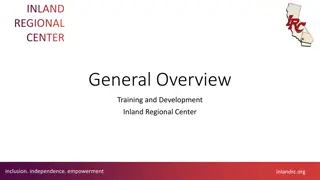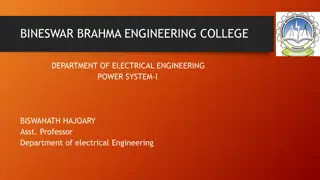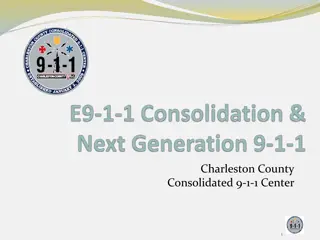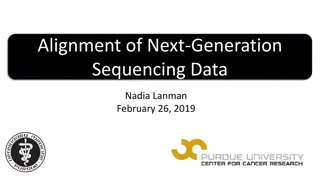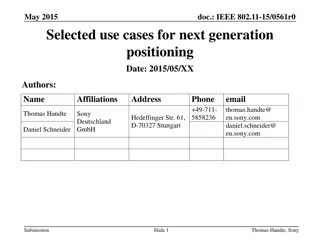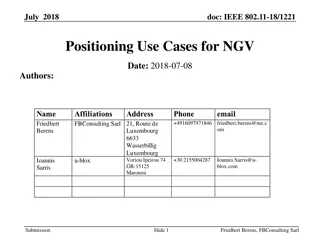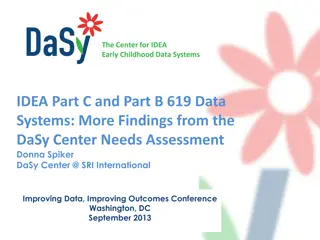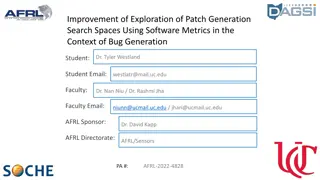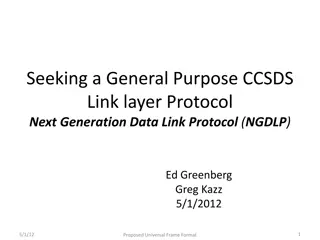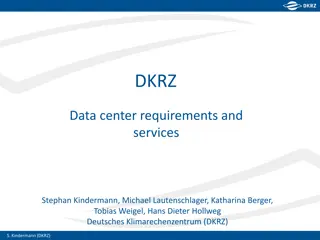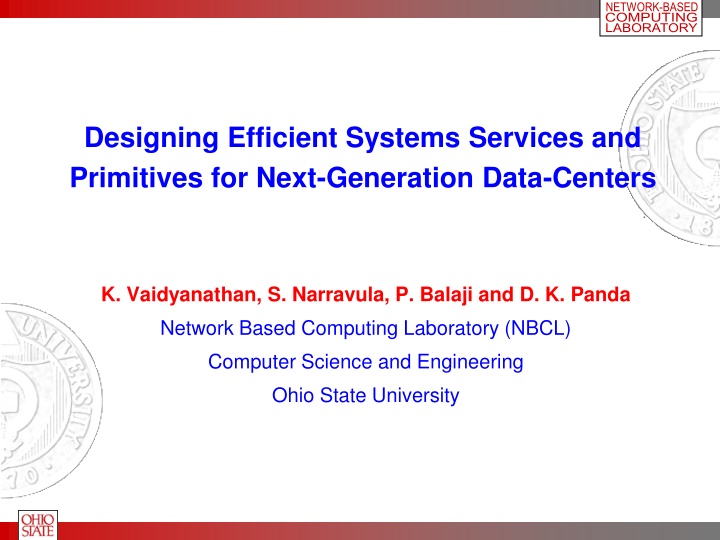
Next-Generation Data-Center Systems Services
Designing efficient systems and services for next-generation data-centers is crucial for interactive data-driven applications in scientific, enterprise, and commercial domains. This involves processing static and dynamic datasets, interacting, synthesizing, and visualizing large datasets through data-centers, which enable clients to query specific data. A multi-tier data-center environment with web servers, proxy servers, storage, database servers, and application servers handle client requests over the WAN, performing caching, load balancing, and processing business logic. The research focuses on proposing a novel framework for next-generation data-centers to enhance performance, scalability, and features like active caching, resource monitoring, and dynamic resource adaptation utilizing advanced network capabilities like InfiniBand and RDMA-enabled networks. The architecture includes advanced communication protocols, data-center primitives, and services to deliver efficient data processing capabilities.
Download Presentation

Please find below an Image/Link to download the presentation.
The content on the website is provided AS IS for your information and personal use only. It may not be sold, licensed, or shared on other websites without obtaining consent from the author. If you encounter any issues during the download, it is possible that the publisher has removed the file from their server.
You are allowed to download the files provided on this website for personal or commercial use, subject to the condition that they are used lawfully. All files are the property of their respective owners.
The content on the website is provided AS IS for your information and personal use only. It may not be sold, licensed, or shared on other websites without obtaining consent from the author.
E N D
Presentation Transcript
NETWORK BASED COMPUTING LABORATORY Designing Efficient Systems Services and Primitives for Next-Generation Data-Centers K. Vaidyanathan, S. Narravula, P. Balaji and D. K. Panda Network Based Computing Laboratory (NBCL) Computer Science and Engineering Ohio State University
NETWORK BASED COMPUTING LABORATORY Introduction and Motivation Interactive Data-driven Applications Scientific as well as Enterprise/Commercial Applications Static Datasets: Medical Imaging Modalities Dynamic Datasets: Stock value datasets, E-commerce, Sensors Need for interacting, synthesizing and visualizing large datasets Data-centers enable such capabilities Clients initiate queries (over the web) to process specific datasets Data-centers process data and reply to queries
NETWORK BASED COMPUTING LABORATORY Typical Multi-Tier Data-center Environment Web-server (Apache) Proxy Server Clients Storage More Computation and Communication Requirements WAN Database Server (MySQL) Application Server (PHP) Requests are received from clients over the WAN Proxy nodes perform caching, load balancing, resource monitoring, etc. If not cached, the request is forwarded to the next tiers Application Server Application server performs the business logic (CGI, Java servlets, etc.) Retrieves appropriate data from the database to process the requests
NETWORK BASED COMPUTING LABORATORY Overview of Research Propose a novel framework for next generation data-centers Delivering performance and scalability Providing advanced features such as active caching, fine-grain resource monitoring, dynamic resource adaptation, etc Novel approaches using the advanced features of InfiniBand and other RDMA-enabled Networks Resilient to the load on the back-end servers Order of magnitude performance gain for several scenarios Exploit features like RDMA and remote atomic operations for new primitives and services Three-layer Architecture Advanced Communication Protocol Support Data-Center Primitives Data-Center Services
NETWORK BASED COMPUTING LABORATORY Proposed Architecture Existing Data-Center Components Dynamic Content Caching Active Resource Adaptation Advanced System Services Active Caching Caching Active Cooperative Caching Caching Cooperative Dynamic Reconfiguration Reconfiguration Dynamic Resource Monitoring Monitoring Resource Distributed Data Sharing Substrate Distributed Data Sharing Substrate Data-Center Service Primitives Soft Shared Soft Shared State State Point To Point Distributed Lock Distributed Lock Manager Manager Global Memory Aggregator Advanced Sockets Direct Protocol Communication Protocols and Subsystems Packetized Flow-control Async. Zero-copy Async. Zero-copy Communication Communication Protocol Offload Network RDMA Atomic Multicast
NETWORK BASED COMPUTING LABORATORY Publications (So Far) Architecture for Caching Responses with Multiple Dynamic Dependencies in Multi-Tier Data-Centers over InfiniBand, CCGrid 2005 On the Provision of Prioritization and Soft QoS in Dynamically Reconfigurable Shared Data-Centers over InfiniBand, ISPASS 2005 Asynchronous Zero-copy Communication for Synchronous Sockets in the Sockets Direct Protocol (SDP) over InfiniBand, CAC 2006 Designing Efficient Cooperative Caching Schemes for Multi-Tier Data- Centers over RDMA-enabled Networks, CCGrid 2006 Exploiting RDMA operations for Providing Efficient Fine-Grained Resource Monitoring in Cluster-Based Servers, RAIT 2006 DDSS: A Low-Overhead Distributed Data Sharing Substrate for Cluster-Based Data-Centers over Modern Interconnects, HiPC 2006 High Performance Distributed Lock Management Services using Network-based Remote Atomic Operations, CCGrid 2007 http://nowlab.cse.ohio-state.edu/projects/data-centers/index.html
NETWORK BASED COMPUTING LABORATORY Sockets Direct Protocol: Throughput and Overlap Throughput Comp./Comm. Overlap 12000 10000 9000 10000 BSDP 8000 BSDP ZSDP 7000 8000 ZSDP Throughput (Mbps) AZ-SDP Throughput (Mbps) 6000 AZSDP 6000 5000 4000 4000 3000 2000 2000 1000 0 0 1 4 16 64 1K 4K 1M 256 16K 64K 256K 0 20 40 60 80 Delay (usec) 100 120 140 160 180 200 Message Size (Bytes) Asynchronous Zero-copy Communication for Synchronous Sockets in the Sockets Direct Protocol (SDP) over InfiniBand, P. Balaji, S. Bhagvat, H. W. Jin and D. K. Panda. Workshop on Communication Architecture for Clusters (CAC); with IPDPS 06.
NETWORK BASED COMPUTING LABORATORY Presentation Layout Introduction and Motivation Cooperative Caching Services Resource Monitoring Services Conclusions and Ongoing Work
NETWORK BASED COMPUTING LABORATORY Cooperative Caching Services Aggregate cache benefits well known!! Performance considerations Two-sided operation vs. One-sided RDMA operations Placement of data ( Local Vs. Remote) Controlling data redundancy Utilize available remote memory Load sensitive Protocols Objective Can we design efficient cooperative caching schemes utilizing the idle resources in the Data-Centers and the RDMA capabilities in networks and eliminate redundancy to optimize available system cache size?
NETWORK BASED COMPUTING LABORATORY Data-Center Throughput with Cooperative Caching 8-Proxy nodes 35000 30000 25000 T P S 20000 15000 10000 5000 0 Apache Caching Basic Cooperative Caching Without Redundancy Multi-Tier Aggregate Cooperative Caching Hybrid Cooperative Caching Cooperative Caching 8k 16k 32k 64k Our schemes achieve significant performance gain over basic Apache Caching (AC) Designing Efficient Cooperative Caching Schemes for Multi-Tier Data-Centers over RDMA-enabled Networks, S. Narravula, H. -W. Jin, K. Vaidyanathanand D. K. Panda. In International Symposium on Cluster Computing and the Grid (CCGrid), 2006
NETWORK BASED COMPUTING LABORATORY Presentation Layout Introduction and Motivation Data-center Service Primitives Cooperative Caching Services Resource Monitoring Services Conclusions and Ongoing Work
NETWORK BASED COMPUTING LABORATORY Resource Monitoring Services Traditional approaches Coarse-grained in nature Assume resource usage is consistent throughout the monitoring granularity (in the order of seconds) This assumption is no longer valid Resource usage is becoming increasingly divergent Fine-grained monitoring is desired but has additional overheads High overheads, less accurate, slow in response Can we design fine-grained resource monitoring scheme with low overhead and accurate resource usage?
NETWORK BASED COMPUTING LABORATORY Synchronous Resource Monitoring using RDMA (RDMA-Sync) CPU CPU App App Threads Threads Front-end Monitoring Process Back-end Node Front-end Node Memory Memory User Space User Space /proc RDMA Kernel Space Kernel Space Kernel Data Structures
NETWORK BASED COMPUTING LABORATORY Impact of Fine-grained Monitoring with Applications Impact on RUBiS and Zipf Traces 40% 35% 30% 25% % Improvement 20% 15% 10% 5% 0% = 0.9 = 0.75 Zipf alpha values = 0.5 = 0.25 Socket-Sync RDMA-Async RDMA-Sync e-RDMA-Sync Our schemes (RDMA-Sync and e-RDMA-Sync) achieve significant performance gain over existing schemes Exploiting RDMA operations for Providing Efficient Fine-Grained Resource Monitoring in Cluster- Based Servers, K. Vaidyanathan, H. W. Jin and D. K. Panda. Workshop on Remote Direct Memory Access (RDMA): Applications, Implementations and Technologies, 2006
NETWORK BASED COMPUTING LABORATORY Work-in-Progress Data-Center Primitives Efficient Global Memory Aggregator Mechanisms Advanced Communication Protocol Mechanisms Efficient Packetized Flow-Control Detailed Data-Center Evaluation with the proposed framework Software release of several data-center components Have received multiple requests from organizations for such a release including a large financial company
NETWORK BASED COMPUTING LABORATORY Conclusions Proposed new protocols, primitives and services for next generation data-centers Use advanced features of InfiniBand and other RDMA-Enabled interconnects Significant performance gains and scalability for several scenarios Potential for designing next generation scalable and high performance data-center architectures
NETWORK BASED COMPUTING LABORATORY Future Challenges Challenges Benefits of all these components and services in an integrated manner for handling Terabytes of data and Multi-thousand users Redesigning middleware and applications on next generation data-centers Significance to the SMA and PDOS components of the program Discussion Bullet How to re-architect next generation data-center architectures, software services, middleware and applications with advances in modern networking technologies and capabilities?
NETWORK BASED COMPUTING LABORATORY Web Pointers Network Based Computing Laboratory NBCL Website: http://www.cse.ohio-state.edu/~panda Group Homepage: http://nowlab.cse.ohio-state.edu Email: panda@cse.ohio-state.edu

